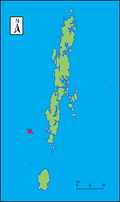North Sentinel Island: Difference between revisions
fixed link |
Sudharsansn (talk | contribs) Fixing link |
||
| Line 4: | Line 4: | ||
[[Image:NorthSentinel Island ISS006-E-33376 sat.jpg|thumb|150px|left|Detail of [[2003]] NASA image (from the [[International Space Station]]) of North Sentinel Island; the island's protective fringe of [[coral reef]]s can be seen clearly. Note this image pre-dates the [[2004 Indian Ocean earthquake|2004 tsunami]], which caused the uplift and exposure of much of the reef.]] |
[[Image:NorthSentinel Island ISS006-E-33376 sat.jpg|thumb|150px|left|Detail of [[2003]] NASA image (from the [[International Space Station]]) of North Sentinel Island; the island's protective fringe of [[coral reef]]s can be seen clearly. Note this image pre-dates the [[2004 Indian Ocean earthquake|2004 tsunami]], which caused the uplift and exposure of much of the reef.]] |
||
North Sentinel Island is home to a tribe of [[indigenous peoples|indigenous people]], the '''[[Sentinelese]]''', whose present numbers are estimated to be anywhere between 50 and 400 individuals. They reject any contact with other people, and are among the last people to remain virtually untouched by modern civilization. Because there has never been any treaty with the people of the island, nor any record of a physical occupation whereby the people of the island have conceded sovereignty, the island exists in a curious state of limbo under established international law and can be seen as a sovereign entity under Indian protection. It is, therefore, |
North Sentinel Island is home to a tribe of [[indigenous peoples|indigenous people]], the '''[[Sentinelese]]''', whose present numbers are estimated to be anywhere between 50 and 400 individuals. They reject any contact with other people, and are among the last people to remain virtually untouched by modern civilization. Because there has never been any treaty with the people of the island, nor any record of a physical occupation whereby the people of the island have conceded sovereignty, the island exists in a curious state of limbo under established international law and can be seen as a sovereign entity under Indian protection. It is, therefore, one of the ''de facto'' [[autonomous regions of India]] |
||
The local government ([[Andaman and Nicobar Islands]]) has recently stated that they have no intention to interfere with the Sentinelese's lifestyle or habitat. |
The local government ([[Andaman and Nicobar Islands]]) has recently stated that they have no intention to interfere with the Sentinelese's lifestyle or habitat. |
||
| Line 11: | Line 11: | ||
==References== |
==References== |
||
<references /> |
<references /> |
||
==Related links== |
|||
* [[Autonomous regions of India]] |
|||
==External links== |
==External links== |
||
| Line 24: | Line 28: | ||
[[Category:Indian Ocean atolls]] |
[[Category:Indian Ocean atolls]] |
||
[[Category:Islands of the Andaman and Nicobar Islands]] |
[[Category:Islands of the Andaman and Nicobar Islands]] |
||
[[de:North Sentinel Island]] |
[[de:North Sentinel Island]] |
||
Revision as of 21:14, 31 January 2009


North Sentinel Island is one of the Andaman Islands in the Bay of Bengal. It lies to the west of the southern part of South Andaman Island, and has an area of 72 km².[1] Officially the island is administered by India as part of the Andaman and Nicobar Islands Union Territory (since 1947).

North Sentinel Island is home to a tribe of indigenous people, the Sentinelese, whose present numbers are estimated to be anywhere between 50 and 400 individuals. They reject any contact with other people, and are among the last people to remain virtually untouched by modern civilization. Because there has never been any treaty with the people of the island, nor any record of a physical occupation whereby the people of the island have conceded sovereignty, the island exists in a curious state of limbo under established international law and can be seen as a sovereign entity under Indian protection. It is, therefore, one of the de facto autonomous regions of India
The local government (Andaman and Nicobar Islands) has recently stated that they have no intention to interfere with the Sentinelese's lifestyle or habitat. Although the island is likely to have suffered seriously from the effects of the December 2004 tsunami, the survival of the Sentinelese was confirmed when, some days after the event, an Indian government helicopter observed several of them, who shot arrows at the hovering aircraft to repel it.
References
- ^ George Weber. "The Andamanese - Chapter 8: The Tribes". pp. part 6. The Sentineli. Retrieved 2007-05-03.
Related links
External links
- "Lonely islands: The Andamanese", comprehensive online documentation by George Weber
- "The Last Island of the Savages", in-depth article by Adam Goodheart
- Brief factsheet about the indigenous people of the Andaman Islands, by the Andaman & Nicobar Administration
- "The Andaman Tribes - Victims of Development"
- Administration in India's Andaman and Nicobar Islands has finally decided upon a policy of minimal interference
- video clips from Survival International
